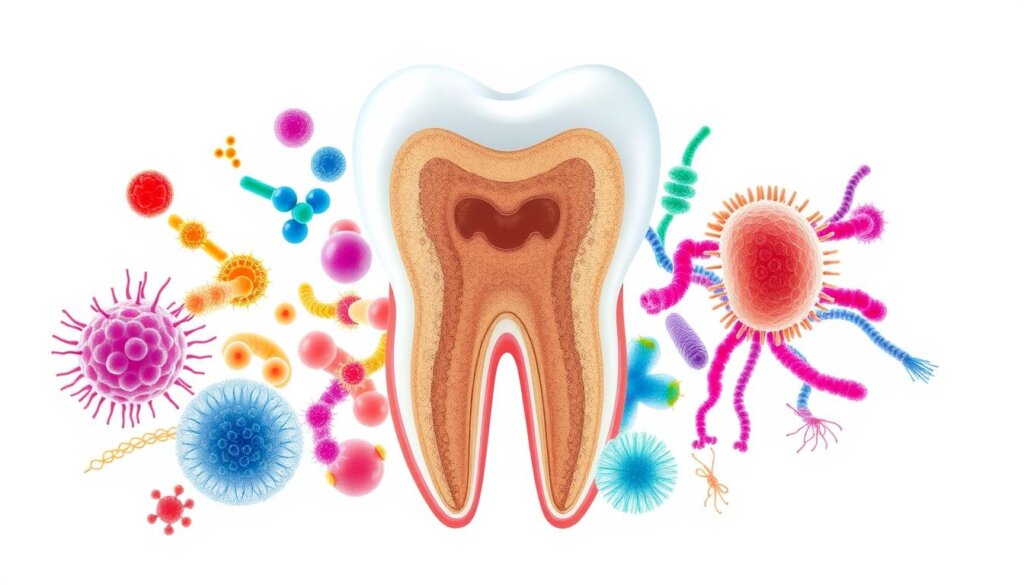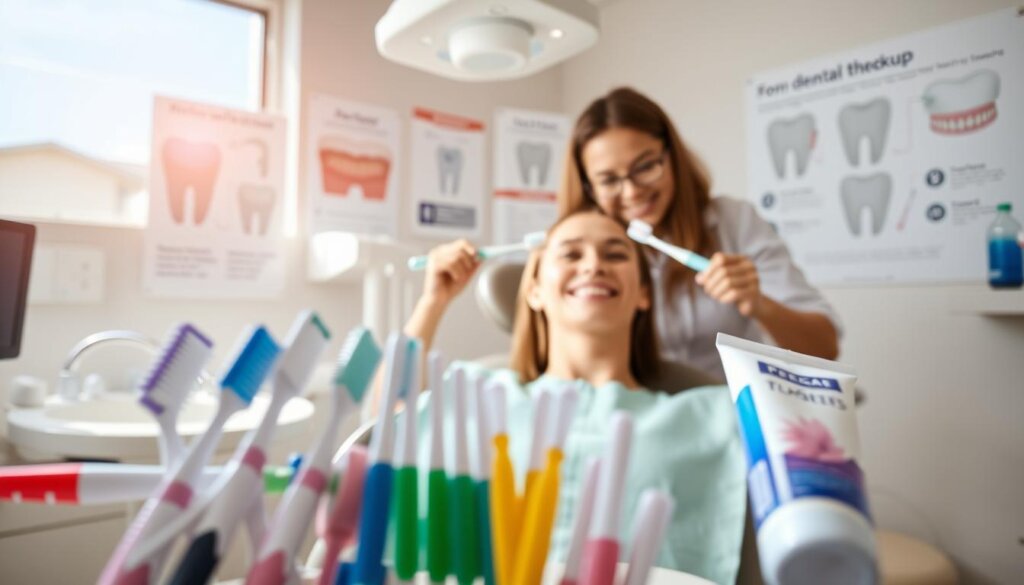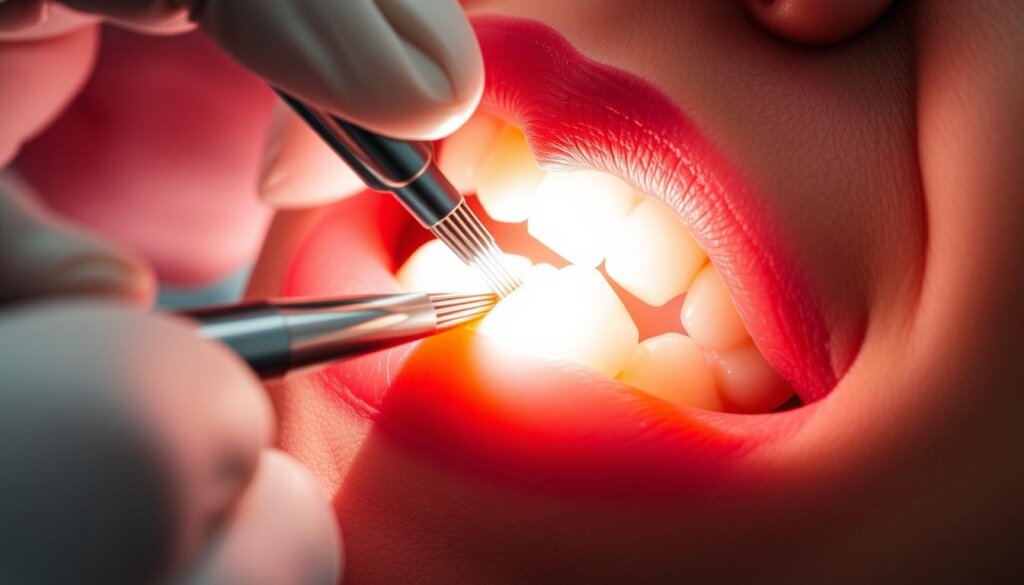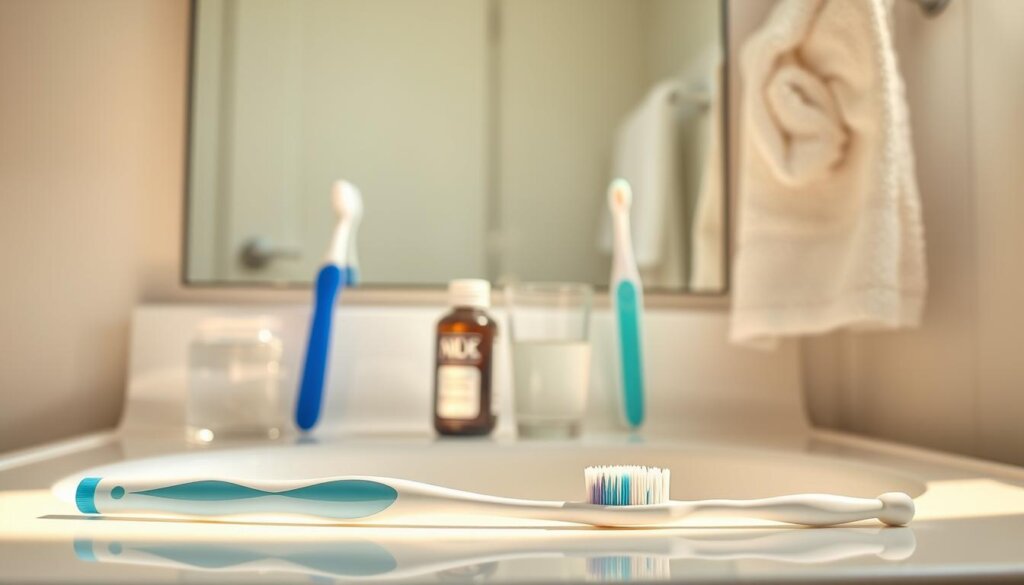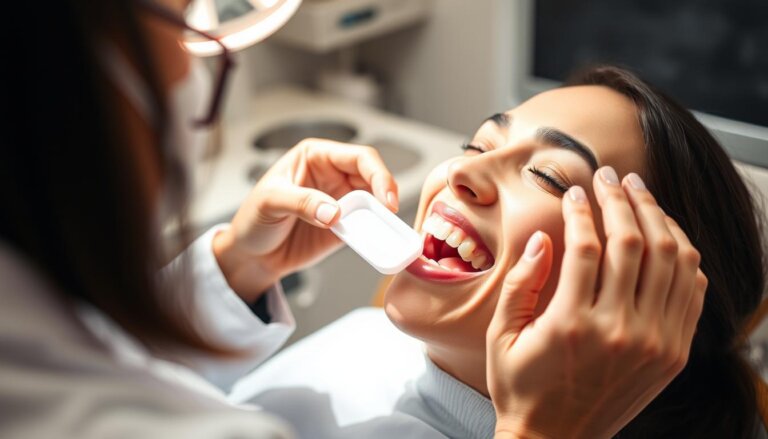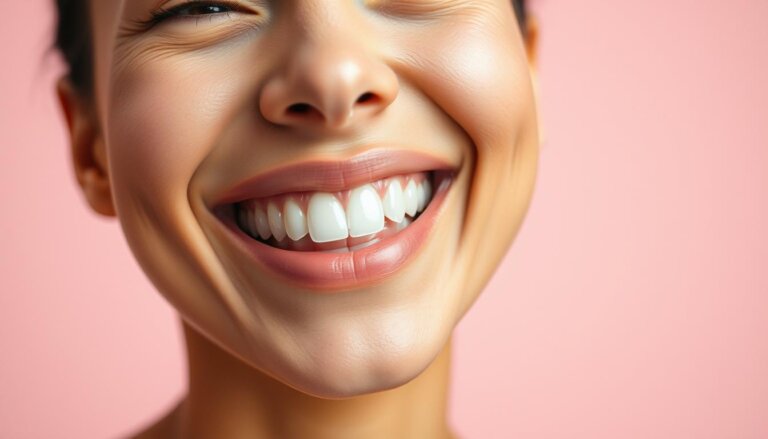What is Plaque and Tartar, and How Do They Affect My Teeth?
Every day, millions are fighting a silent battle in their mouths. Shockingly, about 68% of adults in the U.S. have tartar, according to the CDC. This fact reveals how common dental problems are. It makes us ask: what is plaque and tartar, and even more, how do plaque and tartar affect teeth? Knowing the dental plaque tartar impact on oral health is key for a bright, pain-free smile.
Dental plaque is a sticky, clear film full of bacteria. It clings to your teeth, feeding off food and drink leftovers. If you don’t brush or floss well, plaque stays and turns into tartar. Tartar is tough, yellow or brown, and sticks to teeth so strongly that only dentists can remove it. Without a fight, plaque and tartar can lead to cavities and even gum disease.
Key Takeaways
- The prevalence of dental tartar affects more than two-thirds of the adult population in the U.S., highlighting the need for improved oral hygiene.
- Understanding what is plaque and tartar is a first step towards preventing their harmful effects.
- Regular oral hygiene practices are vital in managing plaque before it transforms into the harder and more problematic tartar.
- Professional dental care is essential for removing tartar, which stands resolute against regular brushing.
- An informed approach to how do plaque and tartar affect teeth can help avert serious oral health issues.
Understanding Oral Health: The Role of Bacteria
Keeping your mouth healthy is about knowing the different bacteria types inside it. Some bacteria help keep the mouth healthy, while others can cause problems like plaque and tartar. To manage these tiny creatures, it’s crucial to follow research-backed dental hygiene tips.
What Are Oral Bacteria?
Oral bacteria are tiny living things in your mouth. They can be good, helping to break down food leftovers, or bad, leading to tooth decay and gum disease. The balance of these bacteria depends on how well you take care of your mouth.
Types of Bacteria in the Mouth
Many bacteria live in your mouth. Good ones include Streptococcus sanguinis and Actinomyces viscosus, which are signs of a healthy mouth. But bad ones like Porphyromonas gingivalis and Streptococcus mutans can cause dental issues. They stick to teeth and gums as plaque, which can turn into tartar if not cleaned well.
Knowing how to keep your teeth clean is key to fighting bad bacteria. Brushing, flossing, and getting dental cleanings are all important. By understanding and taking care of your mouth’s bacteria, you can prevent many dental problems.
Defining Plaque: What You Need to Know
Understanding dental plaque is key to protecting your teeth. We’ll look into what it’s made of and its effects on oral health. With this info, you can better prevent plaque and tartar, keeping your mouth healthy.
Composition of Dental Plaque
Dental plaque is a complex mix mainly of bacteria, not just something to brush away. When food, sugars, and starches meet saliva in your mouth, bacteria thrive. They stick together, creating plaque.
How Plaque Forms on Teeth
Plaque starts to form very soon after you eat or drink. It feels like a fuzzy film on your teeth and starts to appear 4 to 12 hours after brushing. Without regular brushing and flossing, plaque turns into tartar, a harder substance that’s tough to remove and can hurt your dental health.
To fight plaque and tartar, it’s crucial to brush twice a day and floss daily. Regular professional cleanings are also important. They get rid of tartar and clean deeper than you can at home.
Tartar: The Consequence of Neglected Oral Hygiene
When we talk about keeping our mouths healthy, it’s key to know the difference between plaque and tartar. Tartar, also called dental calculus, becomes a big problem if we don’t deal well with dental plaque.
Tartar develops when dental plaque hardens, something that happens faster because of our saliva. If we don’t deal with it quickly using plaque and tartar removal techniques, it sticks to our teeth so strongly that normal brushing and flossing can’t get it off. Tartar mostly gathers near the gums, turning yellow or brown. This not only looks bad but also really affects our oral health.
Understanding the difference between plaque and tartar shows how things get worse when neglected. While you can fight plaque with good care at home, getting rid of tartar needs a dentist’s help. Now let’s look at how they impact dental health:
| Aspect | Plaque | Tartar |
|---|---|---|
| Composition | Soft, sticky film filled with bacteria | Hardened calcified deposit from plaque |
| Visibility | Clear to pale yellow | Yellow to brown |
| Removal Techniques | Brushing, flossing, and mouthwash | Professional scaling and specialized tools |
| Risk to Oral Health | Gum irritation, cavities | Increased risk of gum disease, tooth loss |
Knowing and managing the difference between plaque and tartar is not just for looks. It’s crucial for avoiding bigger oral health problems. Always going for regular dental check-ups and using right plaque and tartar removal techniques are must-dos for keeping our mouths healthy.
The Cycle of Plaque Buildup
Plaque forms and builds up in our mouths due to several key factors. By understanding these, we can better prevent plaque and tartar. It’s really important to control plaque and tartar for good oral health.
- Dietary Choices: Eating foods high in sugars and carbs leads to more bacteria and plaque. We need to watch what we eat to avoid plaque and tartar.
- Oral Hygiene Practices: Brushing and flossing regularly is a must. If we skip these, plaque becomes tartar, which is hard to remove without a dentist’s help.
- Saliva Production: Saliva cleans our mouths and fights bacteria. Not making enough saliva means more plaque. Drinking lots of water and using products that help with saliva can help prevent it.
Keeping a strict routine of dental care and diet is key to stopping plaque and tartar. This routine greatly reduces the need for dental work. This is why knowing and following a good plaque control routine is crucial for our health and for everyone’s health.
Impact of Plaque on Tooth Health
Plaque is a soft, sticky film that collects on your teeth. It is full of bacteria that can harm your dental health. It’s essential to understand how do plaque and tartar affect teeth to keep your mouth healthy. This part talks about how plaque damages tooth enamel and gums. It stresses why it’s so important to have good dental hygiene tips for avoiding plaque and tartar.
Plaque really hurts your teeth by causing cavities and decay. The bacteria in plaque turn sugar into acids. These acids harm tooth enamel, making cavities. If ignored, it could lead to bigger teeth problems. This shows why seeing your dentist often and cleaning your teeth well matters.
- Cavities and Decay
- Immediate assault on enamel from acidic byproducts.
- Potential development into deeper tooth layers, causing pain and infection.
- Gum Disease Development
- Initial inflammation and irritation manifested as gingivitis.
- Progression to periodontitis if plaque accumulates unchecked, risking tooth stability.
To avoid these risks, stopping plaque is key. Brushing, flossing, and using antibacterial mouthwash daily help prevent plaque. Also, getting your teeth professionally cleaned removes tartar. Tartar is plaque that’s turned hard and can’t be brushed away. These steps are top dental hygiene tips for avoiding plaque and tartar. They’re crucial for keeping your teeth and mouth healthy.
The Dangers of Tartar on Oral Health
Dental plaque turning into tartar is a big problem in dentistry. It affects your mouth’s health a lot. Knowing how plaque becomes tartar shows why it’s important to get rid of them.
At first, dental plaque is a soft, sticky film on your teeth. You can remove it by brushing and flossing every day. But if you don’t, it can get hard and turn into tartar. Tartar sticks to your teeth strongly and is hard to get off.
Tartar buildup is bad, especially near your gums. It can make gum disease start by letting bacteria grow near your gums. This causes redness and swelling. Tartar makes it harder to keep your mouth clean, leading to worse oral health problems.
If gum disease gets worse, it can turn into periodontitis. This is more serious and can make you lose your teeth. It can even impact your whole body’s health. So, it’s key to understand how dental plaque and tartar affect your mouth.
To fight tartar, dentists do treatments like scaling and polishing. These help stop gum disease from getting worse. They keep your mouth healthy. Going to the dentist regularly and cleaning your teeth well at home are important. They help protect you from tartar’s bad effects on your oral health.
Symptoms of Plaque and Tartar Buildup
Spotting plaque and tartar early is key for healthy teeth and gums. It helps you avoid bigger dental problems. Knowing the signs of plaque and tartar helps you take care of your teeth early.
“Early detection and management of oral plaque and its hardened counterpart, tartar, significantly reduce the risk of gum disease and tooth decay.”
Signs of plaque and tartar include yellow or brownish buildup by your gums. This buildup often shows at the bottom of your teeth. You might also notice bad breath or a weird taste, even if you brush regularly.
- Visible yellow or brownish deposits at the gum line
- Chronic bad breath
- Unpleasant taste in the mouth
If you ignore these signs, your oral health could worsen. Plaque turns into tartar if not cleaned off. Tartar is tougher and needs a dentist to remove. Without care, this can lead to worse problems:
| Condition | Impact |
|---|---|
| Cavities and Decay | Leads to tooth structure damage and potential tooth loss |
| Gum Disease | Can progress to periodontitis, affecting gum health and jawbone integrity |
| Tooth Loss | Severe cases may result in the need for prosthetics or dental implants |
It’s crucial to take steps towards plaque and tartar control. Visiting your dentist regularly and using the right brushing and flossing methods are good ways to keep your mouth healthy. This will help keep plaque at bay and stop tartar from forming.
Plaque vs. Tartar: Key Differences
Knowing the difference between plaque and tartar is key for great oral health. Both affect how teeth work and their health, but in unique ways.
Formation and Removal of Plaque
Plaque is a soft, sticky layer that forms on teeth, made of bacteria and food bits. It happens when mouth bacteria mix with sugars and starches, making an acid that sticks to teeth. Luckily, brushing and flossing every day gets rid of plaque, stopping worse dental problems.
The Stubbornness of Tartar
Not removing plaque turns it into tartar, which is a calcified material. Tartar sticks to tooth enamel strongly and is tougher than plaque. It can’t be cleaned away with just brushing or flossing at home. Getting rid of tartar needs a dentist’s help, using special tools.
Understanding the difference between plaque and tartar helps people know how they affect teeth. It encourages them to take better care of their oral hygiene. This way, they can stop plaque from turning into tartar, avoiding major tooth and gum diseases.
Tips for Preventing Plaque Buildup
Keeping your mouth healthy is all about stopping plaque and tartar. We’ll share top tips for great dental hygiene below. These will cover everyday habits and why regular dentist visits are key.
Daily Oral Hygiene Practices
- Brush teeth at least twice a day with fluoride toothpaste to remove plaque and protect enamel.
- Floss daily to eliminate food particles and plaque from between teeth and along the gum line.
- Use an antibacterial mouthwash to help reduce plaque levels and freshen breath.
- Limit intake of sugary and starchy foods that can contribute to plaque formation.
Importance of Regular Check-Ups
It’s crucial to see a dentist every six months, not just for cleanings. They remove tartar that brushing and flossing can’t get rid of. They can also catch and treat early signs of oral health problems. This leads to better dental health.
By following these easy dental hygiene steps, you don’t just fight off plaque and tartar. You also boost your overall health. Good oral care keeps your smile beautiful and supports your body’s health for a long time.
Professional Dental Treatments for Tartar
To get rid of tartar on teeth, you need expert dental care. These treatments aim to remove tough deposits with plaque and tartar removal techniques. Starting with a basic procedure called scaling is common.
Scaling gets rid of plaque and tartar from the teeth and gums. Dentists use special tools for this. After scaling, the next step is polishing. This makes it hard for plaque to stick again.
If tartar has caused gum disease or is below the gum line, more steps might be needed:
- Root Planing: This deep cleaning removes plaque and tartar from tooth roots. It helps gums heal and reduces pocket size.
- Periodontal Therapy: This can include surgery to fix tissues and make periodontal pockets shallower.
These professional dental treatments are key not just for removing tartar. They also prevent issues caused by tartar buildup. Seeing your dentist regularly helps catch and manage plaque and tartar early. This keeps your teeth healthy for a long time.
The Link Between Diet and Plaque Formation
What we eat is crucial for keeping our mouths healthy. It greatly affects how much dental plaque forms. Knowing how diet prevents plaque is key for everyone, not just dentists. Foods rich in sugars and starches make mouth bacteria thrive. This raises the chances of getting plaque.
Foods That Contribute to Plaque
- Candy and sweets that stick to the teeth
- Starchy foods like bread and potato chips
- Carbonated soft drinks and fruit juices with high sugar content
- Alcoholic beverages that dry out the mouth
Beneficial Foods for Oral Health
- Crunchy fruits and vegetables (e.g., apples, carrots)
- Dairy products such as cheese and yogurt, which help balance mouth pH
- Green teas that contain fluoride
- Water, especially when fluoridated, to help rinse away food particles
It’s wise to eat foods that boost oral health daily. Doing so fights plaque effectively. By making smart food choices, you can keep dental problems at bay.
Understanding the Role of Fluoride
Fluoride is a natural mineral that fights dental diseases. It stops plaque from forming and keeps teeth healthy. Adding fluoride to your daily oral care makes your teeth tough against decay.
How Fluoride Helps Prevent Plaque
Fluoride makes tooth enamel stronger to fight off acid from bacteria. This stops plaque and tartar from starting. Getting enough fluoride reduces tooth decay and is key for healthy teeth.
Finding the Right Products
To find the right fluoride products, look at toothpastes and mouthwashes. Each is made to help you keep your teeth in top shape.
- Toothpastes with fluoride
- Mouth rinses containing fluoride
- Professional fluoride treatments available at dental offices
| Product Type | Fluoride Content | Recommended Usage |
|---|---|---|
| Toothpaste | 1000-1500 ppm | Twice daily |
| Mouth Rinse | 250 ppm | Once daily, post-brushing |
| Professional Rinse | 5000 ppm | Periodic use as advised by dentist |
Controlling plaque and tartar is about preventing it, not just removing it. Using products with fluoride daily is essential for strong, healthy teeth and overall oral health.
The Importance of Mouthwash in Oral Care
Mouthwash is key in oral hygiene, especially against dental plaque and tartar. Knowing the role of mouthwash in oral hygiene and the types helps improve dental health.
Using mouthwash every day helps clean plaque and prevent gum disease and cavities. It’s crucial to pick the right mouthwash and use it at the right time. This is important when thinking about how do plaque and tartar affect teeth.
Types of Mouthwash That Combat Plaque
- Antibacterial Mouthwashes: They have ingredients like chlorhexidine to slow down bacterial growth that causes plaque.
- Fluoride Mouthwashes: Fluoride strengthens tooth enamel to fight off tartar and plaque damage.
- Natural Formulas: Made with things like tea tree oil and peppermint, they offer a natural way to fight plaque without harsh chemicals.
When To Use Mouthwash
Mouthwash works best when used twice daily after brushing and flossing. Swishing it around your mouth for 30 to 60 seconds reaches the spots your toothbrush can’t. This method helps in cleaning your teeth better, protecting against how do plaque and tartar affect teeth. It shows why mouthwash is so important in keeping your mouth clean.
Children’s Dental Health: Teaching Good Habits
Teaching kids to care for their teeth early is key for children’s dental health. Teaching good oral hygiene habits does more than keep teeth clean. It sets up a foundation for a lifetime of healthy teeth and gums. This early teaching is super important for keeping smiles bright into adulthood.
The Importance of Early Education
Learning to brush and floss right is the start. Parents and schools need to help kids make these tasks daily habits. Plus, kids should see dentist visits as helpful, not scary. Starting young helps stop plaque buildup and teaches kids to care for themselves.
Fun Ways to Promote Oral Hygiene
Making dental care fun is key to getting kids on board. Things like bright toothbrushes, tasty toothpaste, and apps for brushing make it exciting. Here are fun ideas:
- Turn brushing and flossing into a game with timers and rewards.
- Use stories about characters who show why healthy teeth and gums matter.
- Have interactive charts in schools or dental offices to track progress.
Activities that are fun and teachable boost kids’ efforts in oral care.
The real goal is more than avoiding cavities. It’s about making kids proud of their dental care. By teaching good oral hygiene habits early, we’re preparing healthier future generations. They’ll be ready to keep up with excellent children’s dental health.
Myths and Misconceptions About Plaque and Tartar
Oral health issues are common. Yet, myths about plaque and tartar are widespread. These often lead to poor care and preventable dental issues. Misconceptions can make it hard to keep our mouths healthy. It’s very important to clear up these myths. Knowing the truth helps us follow the best tips for fighting off plaque and tartar.
Common Misunderstandings
- Myth: Tartar is just hardened plaque and is not harmful.
- Reality: Tartar makes it easy for more plaque to build up and can cause serious gum disease and tooth loss if not removed by a dentist.
- Myth: Aggressive brushing can prevent plaque and tartar formation.
- Reality: Brushing too hard can hurt tooth enamel and gums, leading to more plaque.
Debunking Popular Myths
- Myth: Only sugary foods cause plaque.
- Reality: Carbs from any food, even healthy ones like fruits and veggies, can cause plaque if we don’t clean our teeth well.
- Myth: Plaque is only a cosmetic issue.
- Reality: Plaque can cause serious dental problems like cavities and gum disease, which affect our overall health.
It’s important to know the facts and forget the myths about plaque and tartar. With the right information and tips to keep plaque and tartar away, we can all have better oral health. This helps us avoid dental problems as we get older.
Conclusion: Maintaining Oral Health
Our deep look into dental health shows how daily habits affect plaque and tartar build-up. The saying “prevention is better than cure” really means something for oral health. To keep your mouth healthy, brush twice a day with fluoride toothpaste, floss regularly, and use mouthwash.
Recap of Best Practices
Eating healthy is also key to strong teeth and gums. Staying away from oral care myths is important too. These steps make a strong foundation for keeping our mouths healthy for life.
Encouragement for Regular Dental Visits
While taking care of your teeth at home is essential, don’t forget about dentist visits. At the dentist, tartar is professionally cleaned, preventive care given, and small issues are caught early. Both home care and dentist visits are vital in preventing serious dental problems. This is why regular dental check-ups are a must for comprehensive oral health.

